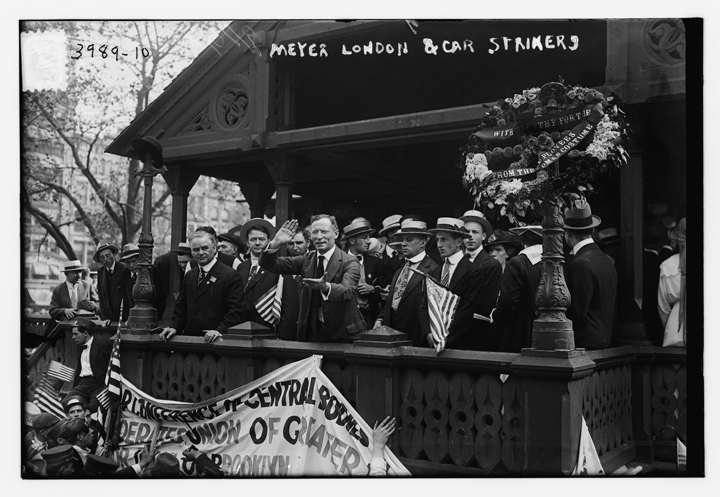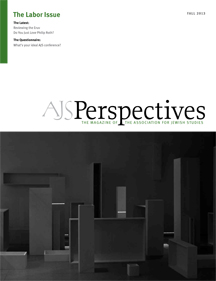
A specifically Jewish Socialist movement arose in the 1880s at the start of the mass migration. But the early movement was divided between Socialists and Anarchists, and aside from a few fleeting victories in strikes, and a heady moment of relevance during Henry George’s radical 1886 campaign for mayor, the Jewish Left had little to show for its efforts before the turn of the century.
The Jewish Socialist movement really came into its own on the electoral front only in the second decade of the twentieth century. By that time it had built powerful institutions—The Jewish Daily Forward, the world’s leading Yiddish newspaper; the Workmen’s Circle, a fraternal order with tens of thousands of members; and the needle-trades unions, which had gained strength after a series of momentous strikes beginning in 1909–10. In 1914, the Lower East Side sent immigrant labor lawyer Meyer London to Congress as a Socialist. In the next several years, Jewish immigrant districts in Manhattan, Brooklyn, and the Bronx elected Socialists to the state assembly and the city board of aldermen. Another Socialist immigrant lawyer, Morris Hillquit, conducted a spectacular “peace and milk” campaign for mayor in 1917 in opposition to American intervention in World War I and calling for measures to ensure adequate nutrition to the city’s poor. Hillquit (a successful corporate lawyer in his day job) finished a strong third in a four-man race, well ahead of the Republican candidate.
At the same time, Jewish labor activists began to influence “mainstream” politicians. The disastrous 1911 Triangle Shirtwaist Company fire, which killed 146 workers, most of them young Jewish women, gave a push to the Socialist movement. But it also impelled non-Jewish Tammany Hall Democrats such as State Assemblyman Al Smith and State Senator Robert F. Wagner to take the lead in investigating factory conditions in New York State. The legislators received instruction from Jewish labor activists Rose Schneiderman, Pauline Newman, and Clara Lemlich, who served as their guides through the state’s industrial system. (Later, when he served as governor, another Jewish woman would become Smith’s top aide and progressive conscience. Though Belle Moskowitz did not emerge from the labor movement, she had served as impartial arbitrator for the dress and waist industry.)
During the 1920s, New York’s Socialist movement sojourned in the political wilderness, weakened by a combination of state repression, splits with the Communists, gerrymandering, coalition campaigns by Democrats and Republicans, and the gradual dispersal and upward social mobility of its prime constituency—Jewish immigrants. But in the 1930s, the movement entered the mainstream by devising a new electoral strategy—making use of an unusual feature of New York election law that allowed parties to “cross-endorse” each other’s candidates. (To this day, a candidate can appear on the ballot lines of more than one party in New York.) In 1936, most of the Jewish labor movement—including the garment unions, the Forward, the Workmen’s Circle—joined with the former right wing of the Socialist Party and some other independent liberals to form the American Labor Party. Over the next several years, the ALP became a powerful factor in New York politics—backing the candidacies of progressive Democrats like President Franklin Roosevelt and Governor Herbert Lehman, and New Deal Republicans like Mayor Fiorello La Guardia, who soon enrolled as an ALP member and made the new party his chief electoral vehicle. The ALP also sometimes ran its own candidates. In Jewish districts, the ALP was often the second, and sometimes even the first, party.
However, internal conflicts concerning issues of particular relevance to Jews soon tore the party apart. The party had been founded by anti-Communist social democrats, but the Communist Party infiltrated local ALP clubs in keeping with the Moscow-dictated Popular Front line of alliance with liberals and Socialists against fascism. The party leadership largely ignored the Communist presence until the Hitler-Stalin Pact put an end to the Popular Front in the late summer of 1939. Then, the Communists and their friends within the ALP suddenly reversed their line, vituperatively attacking their erstwhile allies in the anti-fascist movement. The ALP “left” now derided Roosevelt as an “imperialist warmonger” and tried unsuccessfully to block his renomination in 1940 at a tumultuous convention in which police had to intercede. For the next four years, right and left battled for control of the party, even when the Popular Front was ostensibly restored after Germany invaded the Soviet Union. The pro-Soviet faction finally won control of the party in a series of primary contests in 1943 and 1944, in which the Soviet arrest and apparent execution of Polish Bundists Henryk Erlich and Victor Alter became an issue (Erlich actually committed suicide while in prison.)
The right split and formed its own party—the Liberal Party, led by David Dubinsky, president of the International Ladies’ Garment Workers’ Union, and Alex Rose, of the hatters’ union. The Liberal Party played an important role in New York politics for several decades, replacing the ALP, which faded during the early Cold War. The Liberals even reelected Mayor John Lindsay solely on their line after he lost the Republican primary in 1969. Like the ALP, the Liberal Party depended on Jewish districts for its votes and the Jewish labor movement for its material support. While the party chair was always a gentile intellectual—a professor or minister—Yiddish-accented trade unionists Dubinsky and Rose called the shots. By the 1960s, however, the old “Jewish” unions, though led by Jews, had fewer and fewer Jewish members. The social base for Jewish labor politics was thus eroding. The ILGWU quit the party after Dubinsky retired in 1966. Rose died in 1976. With its roots in the Jewish labor movement all but severed, the Liberal Party went into moral and electoral decline. By the end, it was a cynical patronage machine—–not so much a party, as one observer put it, but a “law firm with a ballot line.” Its last hurrah came in 1993, when it helped elect Rudy Giuliani mayor.
New York’s Jewish labor politics arose out of a specific historical experience in eastern Europe and America. Echoes of it still exist today—in New York’s Working Families Party, for example, which seeks to occupy the left-of-center space opened up by the demise of the ALP and Liberal Party. But New York’s Jewish population is changing—with a growing Orthodox sector and a sizable number of immigrants from the former Soviet Union—and likely to become more conservative politically. For the better part of a century, though, Jewish labor infused local New York politics with a social democratic ethos rare in large American cities.

